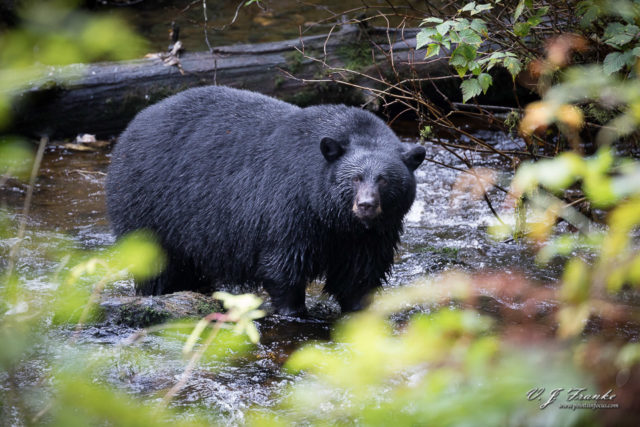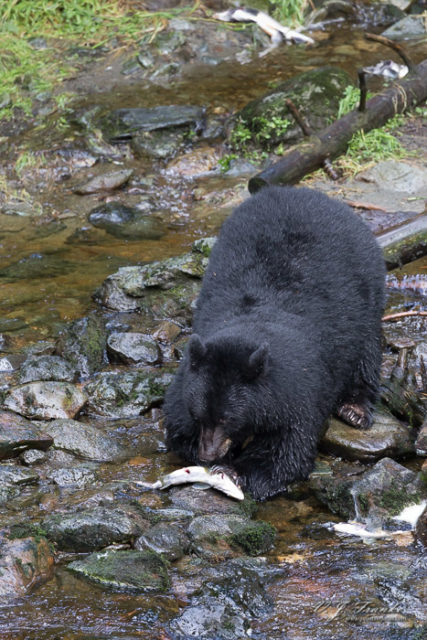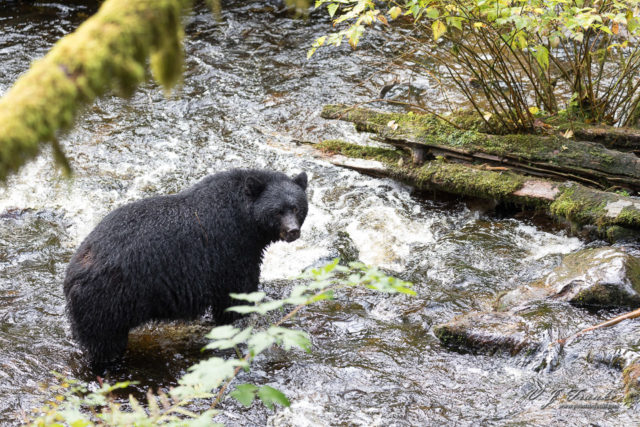Black Bears of Revillagigedo Island (Ketchikan Alaska)
In the fall of 2017, I got another opportunity to go back to Alaska on a cruise. Unlike the first trip, this one would be the very end of the season instead of the very beginning, and this means that I would have the opportunity to photograph bears.
For those sticking to cruises in the southeastern part of Alaska, there are two species of bears you’ll be able to see in the wild: black bears, and brown bears.
In this brief guide, I’m going to cover some broad points about black bears, photographing them, and some specific details that stemmed from my experience photographing them at the Alaska Rainforest Sanctuary just outside of Ketchikan, Alaska.
American Black Bears
When most people think of bears and Alaska, they probably think of the more famous brown bears (Ursus arctos). For that matter, this is the species that when found further inland, like say in Yellowstone National Park, is called the grizzly bear. They’re big, they’re powerful, and the most famously fish for salmon in places like Brooks Falls in Katami National Park.
However, there are two other species of bears found in North America. The polar bear (Ursus maritimus), which is well obviously found in the very north of Alaska and Canada, but range around the whole arctic region including Russia, Greenland, and Norway. And the truly American of the bears, the American black bear (Ursus americanus), which is only found in the North America (Canada, the US, and Mexico).
Black bears are the smallest of the 3 bears found in the North America. A typical male black bear weights between 125 and 550 pounds (57-250 kg), and females are about a third smaller. That said, weight and size will vary by range and time of year. Bears will be considerably lighter just after waking up from hibernating, and considerably heavier before entering hibernation.
The diet of black bears is highly varied, as they are true omnivores. Food sources in southeast Alaska include shoots and sprouts, grubs, insects, berries, and of course salmon. Black bears are also opportunistic and will take advantage of scavenging things like beached whales, moose, and deer carcasses. The bears I ended up photographing were gorging themselves on the pink salmon run. Moreover, they did so with impunity as there are no brown bears on Revillagigedo Island.

Black bears are strong climbers — a typical defensive behavior for black bears is to climb trees, and can make short work of the task.
Additionally black bears are strong swimmers. The guides on my excursion noted that the black bear population on Revillagigedo Island was not isolated from the population on the main land. Additionally I have found reports noting that black bears swim the Behm Canal (avg 1-2 mi in width though narrower in places) that separates Revillagigedo island from the mainland. The distances are within reason, especially the narrower parts, for black bears. That said, I’ve not yet been able to find scientific studies (either direct tracking, or genetic diversity studies) showing the frequency of these transits.
By and large, the ranges for black and brown bears overlap appreciably in Alaska, at least where there is plenty of room[1]. However, in smaller places, such as islands of the Alexander Archipelago in southeast Alaska, bear populations have tended to segregate themselves.
In the Alexander Archipelago, black bear are the only species of bear found on most of the islands except, Admiralty, Baranof, Chichagof, and Kruzof Islands.
Form a photographic perspective, I think the American black bear offers some really interesting potential and strikingly different visual opportunities. Though the typical black bear’s coat is black, their coats can range across the entire gamut of browns and dark browns. Additionally, there are a few extremely interesting color phases worth either keeping eye out for. Or, if you’re especially interested in photographing all phases of black bears, tracking down specifically.
First, there’s the Cinnamon bear (Ursus americanus cinnamomum), which Wikipedia asserts is a both a color phase and a subspecies. Cinnamon bears are, as their name implies, reddish brown or cinnamon colored. Fortunately, they’re considerably more common than the other phases/sub species, with a reported range that covers most of the western US, and Alberta and British Colombia in Canada. Additionally some examples have been seen in the eastern US (New York and Pennsylvania) as well.
Second is the Glacier bear (Ursus americanus emmonsii); these are found in coastal areas of southeast Alaska form Cross Sound to Cape St. Elias, and from Prince William Sound to Glacier Bay. These bears have a silvery blue to gray coat instead of the typical black. Though I’ve personally never seen a bear, let alone a Glacier bear, in Glacier Bay on either of the cruises I’ve been on, their range does extends through the area so it’s not an impossibility either.
Finally there’s the Kermode bear or Spirit bear (Ursus americanus kermodei). These are found in the temperate rain forests of central and northern British Colombia, Canada. What makes the spirit bears special is that 10-20% of them are white, instead of the usual black. These bears play a significant role in the oral traditions of the first people of the areas. Additionally, an interesting note is that they aren’t albinos, the mechanism for their coloration is completely different.
Interesting subspecies and color phases aside, the bears I’ll be showing and talking about in this article are the most common black coated verity, of the most common subspecies the Eastern black bear (Ursus americanus americanus).

NCL’s Bear Country and Wildlife Expedition (The Excursion)
For cruise passengers, choosing an expiation is a balancing act between cost, time in the field, and potential viewing opportunities. Excursions offered by the cruise lines, tend to place a heavy emphasis on insuring that you see what they’re pitching, and they pitch seeing a lot. They can be a good opportunity to cover a lot of ground, but they’re almost certainly going to be geared towards non-photographers and covering as much as possible.
Actually, the latter point, packing in as much as possible, is something of a double edged sword in my opinion. There may be great opportunities for photography that you have to miss because the tour needs to move on to the next thing. There’s a whole lot of, “bear, and native totems, and eagle sanctuary, and salmon bake, and float plane flight” kinds of excursions that try to pack all of that into 2 hours or less. Maybe that’s great if you have a super short attention span, or just want to cover every possible thing you can see, but it always feels rushed to me — even if I’m not trying to take pictures.
My bear photography was done as part of a NCL shore excursion entitled, “Bear Country and Wildlife Expedition.” This excursion was operated by Alaska Rainforest Sanctuary LLC, though according to their website you can book through them directly.
My primary intent in this article isn’t to review this excursion, though I would be remiss if I didn’t at least give a brief commentary on it.
Their tours take place on 40 acres of privately owned land that abuts the Tongass National Forrest on the southeast side of Revillagigedo island, about a 15-20 minutes from the cruise piers. They’ve improved parts of this land with elevated board walk trails that make viewing bears easier, safer, and generally more access able as the entire area is quite steep.
According to our guides, the bears we saw on our tour are completely wild, and there are no fences to keep a population captive on the property. The bears are there, purely because of the breeding salmon in the river.
In many ways the habitat is perfect for black bears. It’s fairly dense coastal rainforest. The area well canopied and there is a lot of natural cover. Moreover, Revillagigedo Island doesn’t have a brown bear population, so there’s no competition from the larger bears to run the black bears off.

As for the excursion itself, I would have no problem recommending it. The guides I had were knowledgeable and friendly. More importantly, the tour itself spent the majority of it’s time on the elevated boardwalk overlooking the bears, which was definitely a plus.
The tour did have a bit of the “kitchen sink” thrown in at the end. However, I felt that they did a good job balancing that with spending the majority of time at the bears and not making everything feel rushed because of it.
The kitchen sink part included a brief stop across the river from a salmon hatchery and a brief commentary on it. This, however, was on the boardwalk back to the visitor center/gift shop, and was only a brief stop anyway.
After that we were taken through an historic sawmill where a Tsimshian totem carver and his wife gave a brief talk about totem carving, the purpose of totems, and the history of totem carving in southeast Alaska. Again, there were quite a few interesting photos to be had while wandering around the sawmill building.
Finally, the last stop was at an outreach raptor center operated by the Alaska Raptor Center. The Alaska Raptor Center is a non-profit organization who’s mission is to rehabilitate and release injured raptors, as well as shelter those that cannot be released. The setup they have here at the Alaska Rainforest Sanctuary allowed some of the best viewing (and photography) of raptors that I’ve seen in 2 curses in Alaska. Of all the 3 extras, I actually wish I had a few more minutes here.
Photographing Black Bears
Black bears, at least the black ones, pose an interesting challenge photographically. Their dark coats tend to blend in with dark shadows in the background especially in dense vegetation — their coats are doing what they’re intended to do, provide camouflage. Compositionally, dealing with this was one of the biggest challenges I found in photographing black bears.
The situation is compounded by the inherent nature of black bears. They generally prefer the cover that a dense canopy and brush provide more than sitting out in the middle of a field. So photographically in addition to all the typical challenges, you also have to try to find angles and lighting conditions that provide some kind of contrast so the bear doesn’t just melt into the shadows.
In general, you have to try and strike a balance in finding backgrounds and angles that provide some separation for the bears, without completely overwhelming them at the same time. In many respects, you have to think about black bears as shadows, and your goal is to try and suss out detail and direct interest towards what’s essentially a shadow.
And of course, you have to manage that while trying to capture interesting images with interesting behaviors and poses.
Additionally, black bears almost never stand still, meaning you’ll need to keep reasonably high shutter speeds to avoid them blurring. Just how high of a shutter speed you’ll need is going to be largely dependent on your camera’s resolution, the lens you’re using, and how active the bears are on that day. I would suggest that 1⁄1000 of a second is a reasonable place to start. However, I had reasonably good luck getting sharp images at shutter speeds as low as 1⁄250, though I wouldn’t rely on that.

Photography at the Alaska Rainforest Sanctuary
With the border notes out of the way, I want to touch briefly on some of the specifics of this sanctuary itself. As I noted already, you’ll be shooting from an elevated boardwalk. This is a bit of a double edged sword for those interested in photography.
On one hand, in my experience (though not with bears) being on a man made structure can afford much better access while reducing stress on the animals. Generally speaking, I’ve found when there is a clear boundary where people are that they don’t leave, wildlife is much more comfortable being much closer than it otherwise would be. Animals recognize that the things on the boardwalk aren’t threats, and go about their business without paying much attention to the people.
On the other hand, being on a boardwalk means you’re shooting down towards the subjects not working on their level. Generally speaking, with wildlife photography it’s preferable at or below the level of you subject — typically low and on the same level of ground as it is. Of course, when photographing dangerous animals, this also puts you in a risky position.
That’s not to say being on a boardwalk is an insurmountable problem, it’s not. What you do want to avoid is shooting straight down on a subject.
On top of that, working from the boardwalks of the sanctuary added a secondary problem; reflections in the water of the river.
Reflections can be effectively addressed with a polarizer, rotated such that it blocks the reflected light. In fact, doing this can allow you to peer into a river that you otherwise couldn’t.
However, polarizers block some light regardless of the polarization. Of course less light means slower shutter speeds or higher ISOs, which is already a problem when working under a dense rainforest canopy.
On the day I was there, I was seeing scenes between 8 and 11 Ev100[2]. As a point of reference, shooting out from under the canopy, I was seeing exposures around 13.7-14 EV100.
With the light of light levels I was seeing, shooting at 1⁄1000 f/5.6 wasn’t especially practical. I could do it, but I would have to be very near ISO 12800. Is that workable? On my 5D mark IV (or really a D850 or Sony A7R III) it’s certainly possible to make good printable images at that high of an ISO. The problem is that you end up losing a lot of fine detail in the bear’s hair; not something I wanted to do. Under the conditions I was working end, I ended up compromising with settings more like 1⁄250–1⁄320 at ISO 1000-3200.
Dropping another stop, either with a slower shutter speed or higher ISO to use a high transmission CPL would have been really pushing it, in my opinion.
Beyond the already mentioned challenges, the photography was otherwise pretty straight forward. When I was there in late September, there were at least 4 or 5 separate bears foraging in the creek below the board walks, and plenty of angles and room to work form.
All told, this was a solid excursion that, at least for me, provided a good opportunity to see and photograph wild black bears doing their thing. That said, as with all wildlife, there is no guarantee that there will be animals in the right place at the right time on any given day. Since these aren’t captive bears, there’s nothing to keep them from wandering off when there isn’t an abundance of food.
- Black Bear range and Brown bear range per the Alaska Department of Fish and Game. ↩︎
- 0 Ev100 is an exposure of 1 sec. at f/1 at ISO 100. Ev 16 is equivalent to the sunny 16 rule (1/ISO at f/16). Ev 8-10 is not especially bight, typical of well lit interiors or exteriors at dusk or dawn. ↩︎

Comments
There are no comments on this article yet. Why don't you start the discussion?